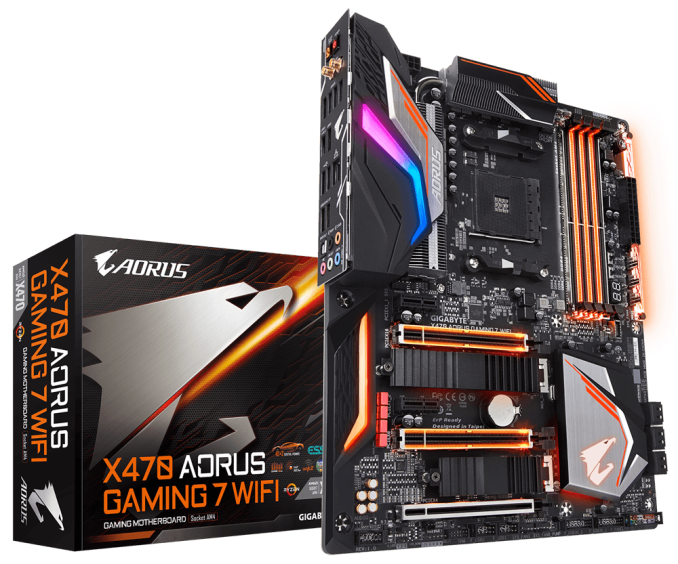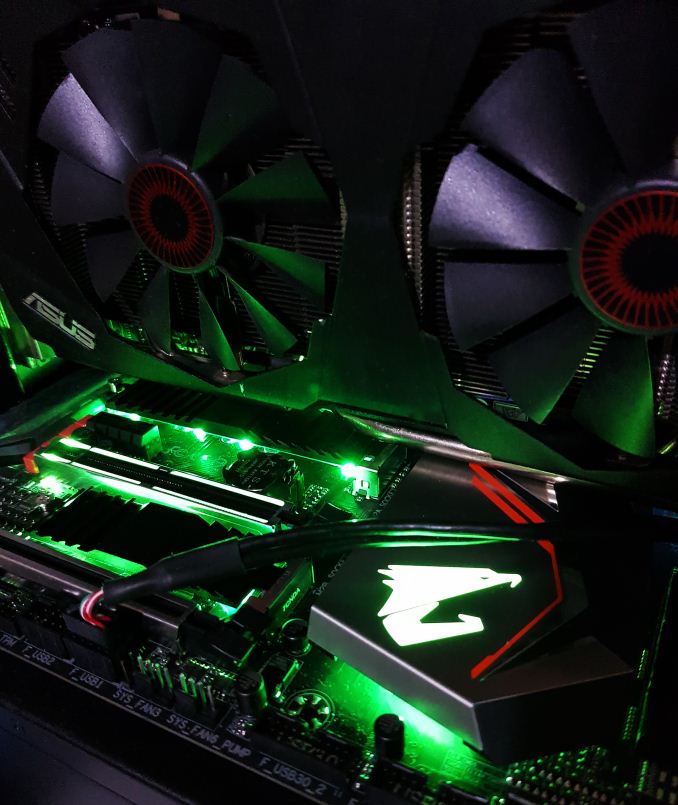The GIGABYTE X470 Gaming 7 Wi-Fi Motherboard Review: The AM4 Aorus Flagship
by Gavin Bonshor on July 26, 2018 8:00 AM EST- Posted in
- Motherboards
- AMD
- Gigabyte
- AORUS
- Ryzen
- X470
- Ryzen 2
- Gaming 7 Wi-Fi
- Gaming 7
GIGABYTE X470 Aorus Gaming 7 Wi-Fi Conclusion
The GIGABYTE X470 Aorus Gaming 7 Wi-Fi has a launch list price of $240 at Amazon US which makes it the most expensive GIGABYTE AM4 motherboard on the market. However, it has the current ‘flagship’ status and has cheaper launch pricing compared to the similarly featured ASUS X470 ROG Crosshair VII Hero ($280) and the MSI X470 Gaming M7 AC ($260). In relation to official memory support, the X470 Gaming 7 Wi-Fi actually has support for faster memory on paper with DDR4-3600.
Overall performance while being compared to previously tested AM4 boards (X370/B350) with our Ryzen 7 1700 ($299) was relatively decent in terms of computational benchmarks, as well as within our DPC latency and other system performance tests. The lackluster gaming results brings the overall results down, however the margins are theme.
While the Aorus brand is primarily targeted towards the gaming crowd, there’s certainly enough overall to make this a well-rounded offering catering to enthusiasts and other power users, as well as gamers. The power delivery has a solid design, and the biggest improvement over the first generation of AM4 boards is the large VRM heatsink which seems a bigger and appreciated improvement over the first generation of AM4 boards released; the design has shades of the 'good old days'. When under full load, it easily coped with the loads without any issues whatsoever; a testament to the change implemented from X370 and one which will be welcomed by many.
Another set of welcomed features is dual BIOS which offers redundancy when flashing to a newer revision; blackouts can happen and I have experienced one myself when updated an older board, let’s just say it wasn’t usable and it may/may not have made the scrap pile. The other is dual NVMe capable PCIe 3.0 x4 M.2 slots which both include a separate and stylish looking black metal heatsink. I have always gone with a function over style preference when selecting new components but having both is a major win in today’s overcrowded RGB all over everything to sell it market.
The board features a full black PCB and has oodles of RGB LED lighting integrated into various zones across the board, making it one of the most customizable from a lighting perspective thanks to the Aorus RGB Fusion software. This makes the board aesthetically pleasing, but it has to be said that the LEDs are rather overpowering and actually detracts from the overall style; of course, this is down to personal preference.
The X470 Gaming 7 Wi-Fi is made even more appealing by its good range of connectivity and choice of controllers including a total of ten USB ports. The rear panel also has a single Intel I211-AT controlled Gigabit LAN port as well as two gold screw on points to make use of the 2T2R 802.11ac Intel based integrated Wi-Fi. GIGABYTE has put a real focus on Wi-Fi, not just in the name, but by adding an the latest Intel 9260NGW 802.11ac Wi-Fi Wave 2 module capable of supporting speeds of up to 1.73 Gbps. The onboard audio comes via the Realtek ALC 1220-VB codec and an ESS SABRE ES9018Q2C digital to analogue converter to further enhance things from an auditory standpoint.
The GIGABYTE X470 Aorus Gaming 7 Wi-Fi is very alluring for gamers and enthusiasts looking to build a powerful AMD based gaming system around Ryzen based CPUs such as the Ryzen 7 1800X ($350) or brand-new Ryzen 7 2700X ($329) eight core processors. Any fatigue felt through the original Ryzen launch in affiliation to launch woes with memory compatibility has been alleviated by AMD and the vendors thanks to faster memory support out of the box; GIGABYTE showing official support for DDR4-3600 when boards from other vendors show DDR4-3466 on launch day offerings is a big plus in the favor of GIGABYTE/Aorus.
Everything summarized, the X470 Gaming 7 Wi-Fi ticks a vast majority of the boxes in relation to compatibility, connectivity and quality throughout and for $240 at launch, it surely has to make the shortlist for any AMD based single or dual graphics card wielding gaming system.
Other AnandTech Ryzen Coverage
- The AMD 2nd Gen Ryzen Deep Dive: 2700X, 2700, 2600X, and 2600 Tested
- The AMD Ryzen 5 2400G and Ryzen 3 2200G APU Review: Marrying Vega and Zen
- The AMD Ryzen 3 1300X and Ryzen 3 1200 CPU Review: Zen on a Budget
- The AMD Ryzen 5 Review: All Ryzen 5 CPUs Tested
- The AMD Zen and Ryzen 7 Review: A Deep Dive on 1800X, 1700X and 1700
- $255 - MSI X370 XPower Gaming Titanium [review]
- $240 - GIGABYTE X470 Aorus Gaming 7 Wi-Fi [this review]
- $175 - GIGABYTE AX370-Gaming 5 [review]
- $160 - ASRock X370 Gaming-ITX/ac [review]
- $110 - Biostar X370GTN [review]
- $98 - MSI B350 Tomahawk [review]
- $90 - ASRock AB350 Gaming K4 [review]












29 Comments
View All Comments
DigitalFreak - Thursday, July 26, 2018 - link
The M.2 slot furthest from the CPU is PCI-E 2.0 x4, not PCI-E 3.0.gavbon - Thursday, July 26, 2018 - link
Good spot, edited and thank you :)DigitalFreak - Thursday, July 26, 2018 - link
One other thing - the 3rd (x4) PCI-E slot is PCI-E 2.0, not 3.0.Hxx - Thursday, July 26, 2018 - link
Gigabyte's BIOS is like the quest to create as many submenus as possible and to bury things as deep as they can be buried within those menus. Luckily my Aorus z370 gaming 7 gets the job doneSpoelie - Thursday, July 26, 2018 - link
Another ATX board :/Wanted to upgrade to Ryzen 2 on an ITX board with a 4xx chipset for "proper" precision boost support - but am still waiting on availability of the damn things.
It's come to a point where I'm contemplating skipping this generation as well and wait for 7nm/Ryzen 3 in H1 next year - a "new" desktop nowadays is 5+ year investment anyway
tarqsharq - Thursday, July 26, 2018 - link
I've had my Asus X470 ITX board since the end of May or so?But yeah, waiting for the 7nm shrink might be a really good idea.
29a - Thursday, July 26, 2018 - link
I'm in the same boat as you Spoelie, I'm wanting to upgrade but I want a board with proper precision boast on a lower end chipset in a uATX or ITX form factor but AMD has been so slow about coming out with the new chipsets that now I'm to the point that I should probably wait for Zen2 and the new GPUs.DanNeely - Thursday, July 26, 2018 - link
I'm not sure which is stupider, the frag harder lights on 2 of the PCIe x16 slots, or that they cheaped out and left the 3rd normal.29a - Thursday, July 26, 2018 - link
Just don't turn them on and what seems to be a major source of stress in your life will go away.29a - Thursday, July 26, 2018 - link
Is it me or is this article hard to read? Here are some examples of strange sentences."While not a budget board in any sense of the phrase ($240), the selection of controllers highly the potential upturn in cost for the X470 Gaming 7. "
"While the X370 predecessor to this board (GIGABYTE AX370 Gaming K7) did feature a single U.2 port, GIGABYTE has omitted to implement one onto the X470 Gaming 7. Instead, two M.2 slots are present with both offering support for NVMe PCIe x4 and SATA SSDs with both slots featuring their own individual stylish and functional M.2 heat sinks."